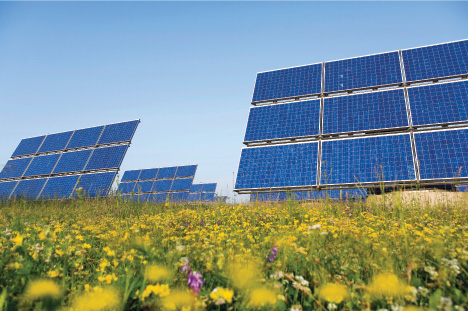A Bright Future
Finally, solar power technologies are having their day in the sun.
Is solar power the heavenly answer to our energy needs? Perhaps. Not only is sunlight clean, abundant, and everlasting — it’s free. Until recently, however, the cost of converting it into electricity was prohibitive — especially when compared with natural gas, which was cheap. But as they say, things change. New technologies are making solar power more cost-effective. Oil and gas prices are rising. And what’s more, many states have enacted laws to push power companies to use cleaner technologies.
California, for instance, declared that 20 percent of its energy must come from renewable sources by 2010, rising to 33 percent by 2012. So last year, the state got its first solar-powered electric plant in 20 years. Built by the U.S.-Australian company Ausra just outside of Bakersfield, Calif., it’s relatively small: just 5 megawatts, enough to supply electricity to 3,500 homes. But more solar plants are on the way. Silicon Valley venture capital firms are hot on solar power; many are investing heavily in companies like Ausra and BrightSource Energy, one of its competitors. BrightSource also got funding from Google.org, the philanthropic arm of the ubiquitous Internet giant.
The rush to solar power will certainly keep engineers from a variety of fields busy for years to come. Because of the mechanics involved — heat transfer, power distribution, new materials — solar-power research and development is multidisciplinary, involving mechanical, electrical, and materials engineers.
The technology pushing the current solar boom is concentrated solar power. The Bakersfield plant, for example, uses mirrors to intensify the sun’s rays and create heat, which is then used to boil water and make steam to power a turbine. CSP plants can store excess heat in oil or molten salt and then use it later to keep the plant running at night or on cloudy days. Ausra claims that plants requiring just 92 square miles of desert land could provide enough juice to meet all of the United States’ electricity needs. CSP costs are falling, and engineers are working on ways to make it even cheaper. Graduate mechanical engineering students at MIT, for example, are working on solar collectors that use ordinary bathroom mirrors and off-the-shelf components.
Solar cells, or photovoltaics, have a future, too, especially for non-grid power. Engineers are looking for cheaper materials and more efficient technologies. An Ohio State University team — made up of a chemist, an electrical engineer, and a materials engineer — recently developed a promising hybrid material from plastic and the metals molybdenum and titanium. Unlike silicon, it absorbs all of the energy sunlight produces. For engineers who opt for a career in solar power, the future’s so bright, they’d better wear shades.
Watch a video on clean, solar energy here:
Filed under: Civil, Environmental, Materials
Tags: Civil, Energy, Environmental, Green Technology, Materials









